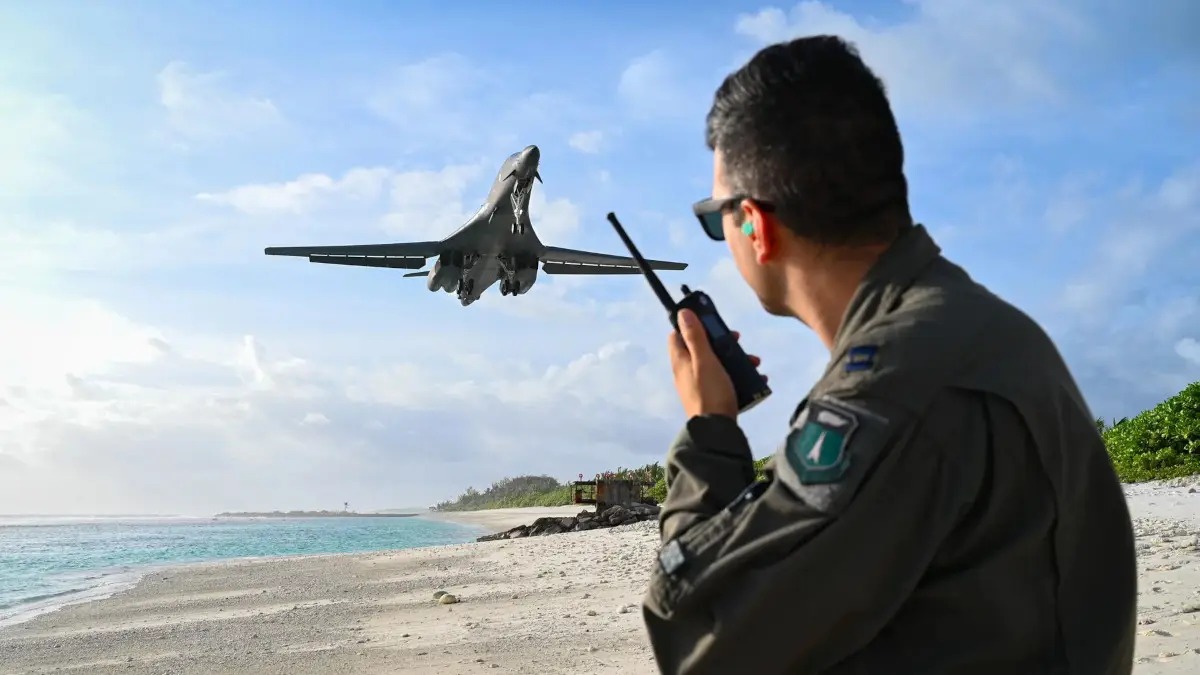With North Korea sending balloons with waste over South Korea as part of a bizarre tactic, the United States sent at least one B-1B bomber to South Korea for joint bombing exercises after a long hiatus of seven years.
The announcement was made by the South Korean Ministry of Defense (MoD) which stated that the US bomber was escorted by South Korean F-15K fighter planes and dropped Joint Direct Attack Munitions at an undisclosed firing range in the nation during the drills, Yonhap News Agency reported on June 5.
The last time such exercises were carried out over the Korean peninsula using the B-1B nuclear-capable bomber was in 2017. “Under close coordination between South Korea and the United States, this exercise took place with a focus on implementing the U.S. extended deterrence commitment and strengthening the combined defense posture,” the ministry reportedly said.
The extended deterrence mentioned is when the United States resolves to defend an ally by deploying its military might, including nuclear weapons.
The Ministry said the South’s F-15Ks participated in the live-fire exercises and showed off their “solid” integrated defensive posture against North Korea’s nuclear and missile threats. During the drills, the B-1B delivered Joint Direct Attack Munitions (JDAM) while being accompanied by South Korean fighters throughout the training. A B-1B is capable of carrying a large conventional weapons payload.
미국 B-1B 전략폭격기 한반도 전개 하 한미 연합공중훈련 시행
✅#한미 는 오늘(6. 5.)미국 B-1B #전략폭격기가 한반도에 전개한 가운데 한미 #연합공중훈련 을 실시했습니다. pic.twitter.com/Da8rDUINqi— 국방부 (@ROK_MND) June 5, 2024
In addition, the US bomber conducted combined air exercises with US F-35B, F-16 jets, and South Korean F-35A and KF-16 fighters. It did not state how many B-1B aircraft were used in the exercise.
It was the second combined air exercise of the allies this year, which included US strategic bombers, according to the ministry.
On April 2, two B-52 bombers and fighter aircraft from the United States, South Korea, and Japan conducted a trilateral aerial exercise southwest of Kyushu Island. This was the first of its kind this year and only the third overall. The drill was reportedly conducted just a few hours after North Korea conducted a hypersonic glide vehicle and intermediate-range ballistic missile test.
The deployment of nuclear-capable bombers to South Korea for military drills appears to be a relatively new strategy in the wake of the warnings issued by Pyongyang. For instance, the US sent its nuclear-capable B-52 bombers to South Korea for the first time in October last year.
While military drills between the US and South Korea are not uncommon, the frequent deployment of nuclear-capable bombers is new. However, it is likely to be condemned by North Korea as the deployment of the bomber has previously been referred to as evidence of US hostility. The previous deployment triggered retaliation from North Korea when it test-launched its weapons.
However, the recent drills involving a US strategic bomber come in the wake of tensions created by North Korea, as Pyongyang continues to send waste-filled balloons over to South Korea. While previously US-South Korea drills followed high-stake missile tests, this time around, excreta-filled balloons have been dispatched from the North.

North Korea’s Waste Balloons Are A Menace
Enraged by South Korean citizens sending balloons carrying pamphlets and other materials into North Korea earlier, Pyongyang floated hundreds of enormous balloons to drop garbage batteries, cigarette butts, dung, and pieces of cloth throughout South Korea last week.
The campaign started late last month and has seen balloons dumping waste and manure upon South Korean towns and cities, including Seoul’s major airport runway.
South Korea’s enemy across the 39th Parallel launched 260-odd balloons into South Korea to deliver waste. According to the Yonhap news agency, the wind-borne balloons dropped waste all across the nation, including as far south as Geochang, about 218 kilometers (135 miles) south of Seoul.
The acts were deemed “dangerous” by the South Korean military, which also sent out chemical and biological warfare reaction teams as well as explosive ordnance disposal units to search and gather the trash bags. Additionally, it sent out notifications to locals, asking them to stay away and call the authorities if they saw anything suspicious. It later clarified that the balloons were not dangerous.
North Korea reportedly launched hundreds of balloons laden with trash across the border into South Korea. The balloons carried items like cigarette butts, plastic and waste paper.
This is allegedly an act of revenge for South Korean activists and defectors sending inflatables… pic.twitter.com/CqmTK0Mk16
— SIKAOFFICIAL🦍 (@SIKAOFFICIAL1) June 3, 2024
Alongside the waste balloon campaign, North Korea tried to interfere with South Korea’s GPS systems. As per reports in local media, North Korea attempted to jam GPS signals near the western sea border in what has been described as the latest “acts of provocation”.
In response, South Korea put on hold a precarious military agreement with North Korea that called for both parties to lower tensions along their border and threatened to take “unbearable” retaliatory measures.
South Korea can now carry out military exercises such as live-fire drills and broadcast propaganda against North Korea over loudspeakers in border areas, largely due to the suspension of the 2018 inter-Korean agreement. Such actions could probably bring provocative actions from North Korea: It is unlikely to pass off the US strategic bombers flying over the peninsula ’lying down.’
- Contact the author at sakshi.tiwari9555 (at) gmail.com
- Follow EurAsian Times on Google News




